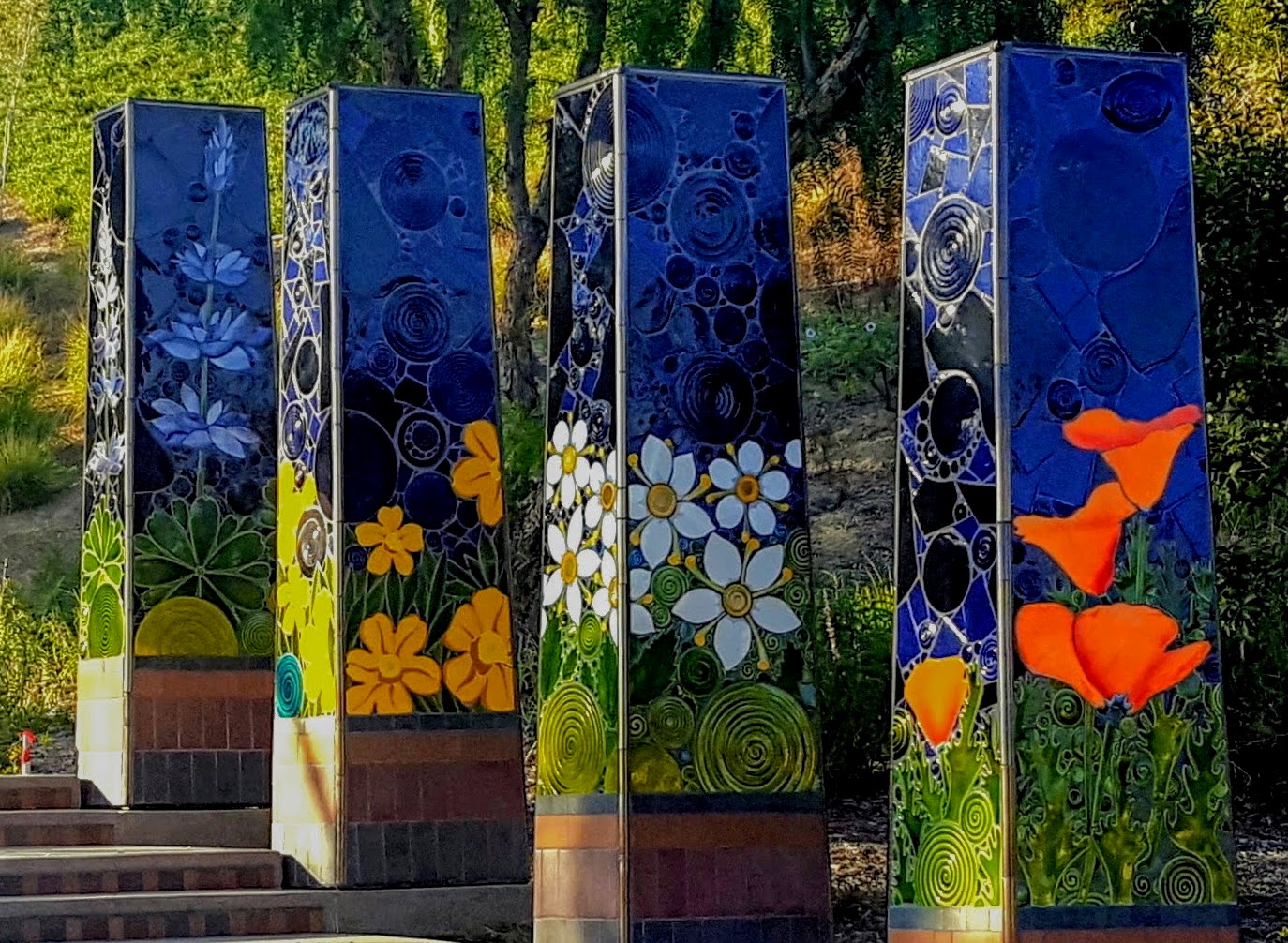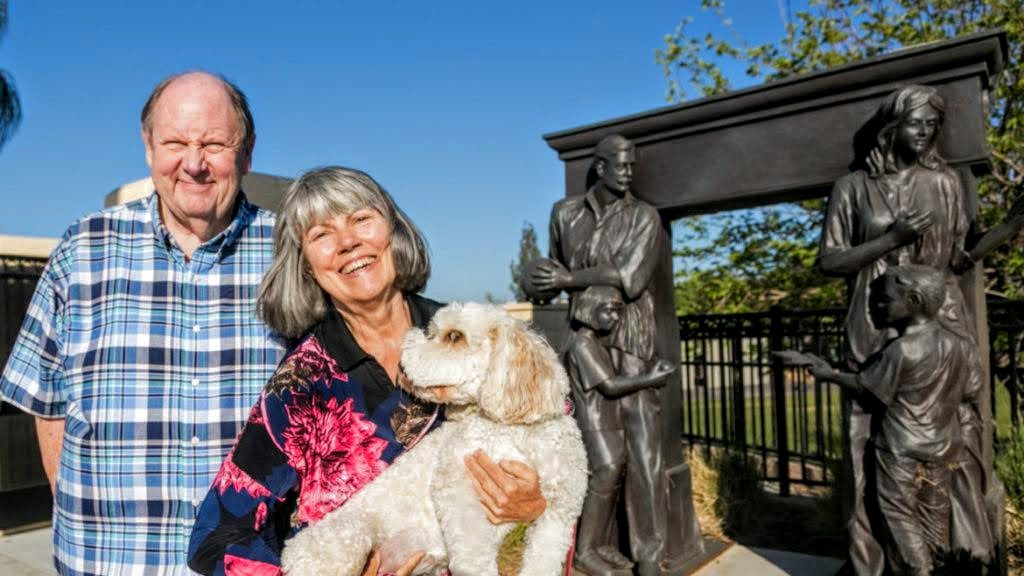
Terry, Dena, and Laurel stand next to “Centennial Door” by artist Carlos Terres at Lagos de Moreno Park on the Laurel Elementary School kindergarten playground. This is the where Dena and Terry met back in 1950. Hence, their labradoodle’s name, Laurel.
Terry Sullivan maneuvers his Honda Civic around Brea’s streets, driveways and office parks with skill and a spot-on sense of direction.
He and his partner of 11 years, Dena Sommer, are on a mission, of sorts. They are the unofficial curators of Brea’s Art in Public Places program. Their self-appointed responsibilities lead to many miles behind the wheel. Brea’s public-private collection of 180 sculptures, bas reliefs and other artworks is spread across the city’s 12 square miles.
On this day, they’re taking a visitor on an abbreviated circuit of the collection, which they estimate is the second largest array of public artwork in the state.
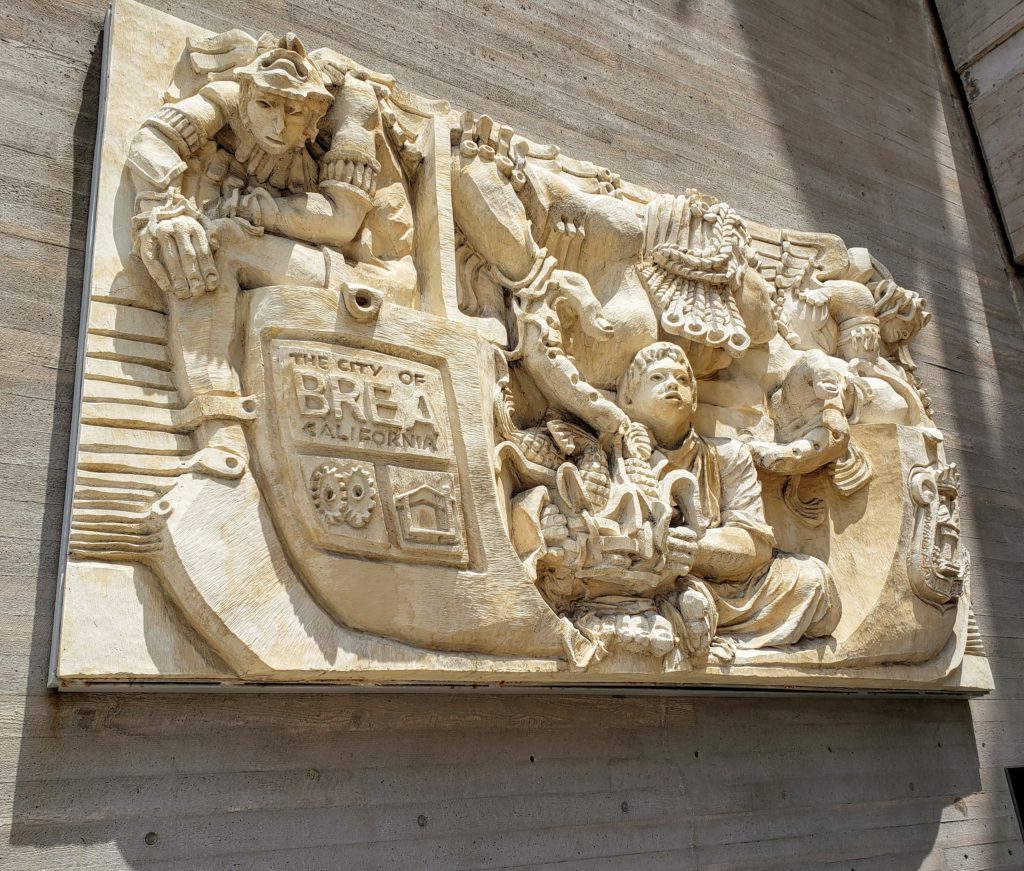
JULIE LEOPO, Voice of OC
“Hermandad” by Carlos Terres, located at the Brea Civic Center on the southeast corner of Birch and Randolph, Brea, CA.
We start at some of the most recent pieces, four new abstract sculptures from Jerome Gastaldi, put up by the developers of the Calligraphy apartment buildings on Central Avenue. Later, we pull up besides Laddie John Dill’s “Tribus,” shiny, colorful panels of cement and glass oxide at the entrance to an Albertson’s Distribution Center; there’s another of his pieces, “Cobalt Basin and Range,” on an adjacent corner.
Next, we park beside Michael Amescua’s “A Moment of Tranquility,” a piece with two standing figures and three tall panels with cutouts that allow a play of light and shadow. The couple bemoan how the paint has been allowed to fade on the 1989 sculpture.
We head off to the city’s northeast corner and the Blackstone Homes residential development, cruising along Santa Fe Road. Sullivan points out nine brightly colored and fanciful tile works on either side of the road, commissioned by Laguna Beach artist Marlo Bartels.
Outdoor artwork takes a beating from the elements. Sullivan and Sommer joke how they had adopted a nickname for Kati Casida’s “Bluebird” when it was painted over in primer: they called it “brown bird.”
Sullivan is anticipating more bad news when he turns onto Saturn Street. At the end of the cul de sac is “Mustangs,” three realistic wild horses frozen in full gallop, their tails flying, hooves off the ground.
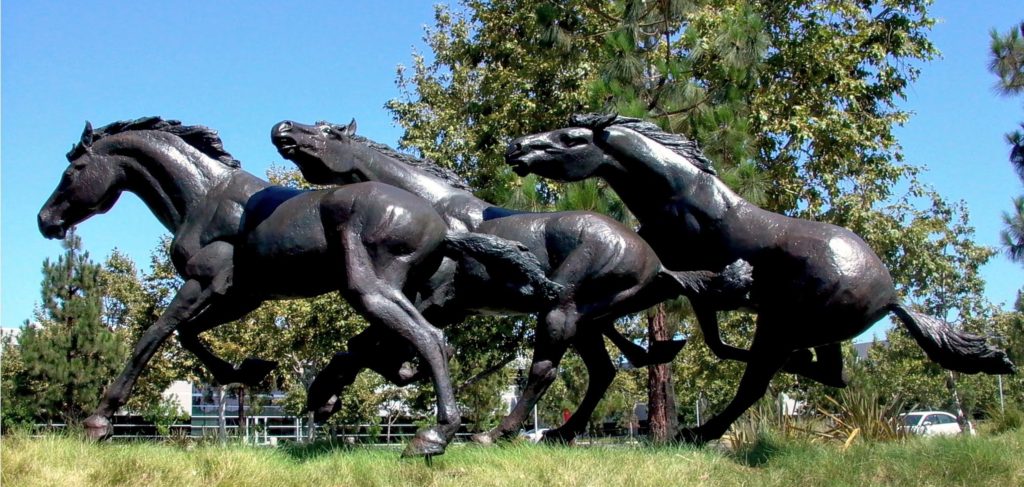
Photo courtesy of Dena Sommer and Terry Sullivan
“Mustangs” by Ray Persinger, located on the east side of Saturn, between Kraemer and Imperial, Brea, CA.
Sullivan had visited artist Ray Persinger’s life-size bronze horses a few days earlier and they were looking pretty filthy, he said. But now, peering through the windshield, Sullivan exclaims with happiness. The sculpture has been cleaned, and perhaps even polished.
“We get pleasantly surprised at times,” says Sommer.
Sullivan and Sommer aren’t just art lovers. They’re friendly watchdogs. They let city officials know when something is amiss with one of the art pieces. They find out about the unveiling of new artwork from art commission meeting minutes, and Sullivan said he’s continuously reminding officials to post the minutes.
And they keep tabs, too, on the companies that own these pieces, which can be tricky, especially when businesses change owners.
At the Brea Mall, Niki de Saint Phalle’s whimsical sculpture “La Lune,” put into a fountain in 1990, has been in storage for several months while the mall was undergoing renovations. Sullivan and Sommer have been calling to find out when it will be put back, but so far have gotten no satisfactory answer. (A spokesman for Simon Property Group, which bought the mall in the late 1990s, said he was not authorized to comment about future exhibition of the piece, but said city officials have been told of the company’s plans.)
Documenting the Collection
Between 2008 and 2012, Sullivan and Sommer spent periodic Sunday mornings going around the city to find and document the entire collection. Sommer took photos, sometimes standing in the street to get an unobstructed image of the artwork.
“I had to get on my back and look straight up,” to photograph “Oil Drill,” she says. During the 2008 financial crisis, “They (the city) couldn’t keep watch on each piece. They had to do layoffs and cut hours. So naturally a project like APP is not going to get a lot of attention in times like that. We were filling in the gaps.”
The duo, both 73, published a book of the complete collection seven years ago, and hope to update it soon. They’ve also created a website, breasartinpublicplaces.com, which has an interactive map of every piece. Their current project is to bring more publicity to the program, which dates back to 1975 but is not particularly well-known, even in Brea. (The city also has a webpage for the collection.)
“About two months ago, we had a meeting with one of the people who is on the Cultural Arts Commission. He found out about us and found we’ve always been frustrated about how little knowledge people have about it,” Sullivan said. “We got together to brainstorm (how) to do things. I have an Instagram page. I’ve now started posting every day on Nextdoor, information about one piece and the artist and a photo.” Sullivan figures he’ll be done with those daily posts by Christmas.
Finding Love and an Art Partner
How Sullivan and Sommer fell into this volunteer mission is also a love story, intersecting with their own personal reunion. They met in kindergarten class at Laurel School in 1950 and remained friends all the way through high school and while at Fullerton College. They then went their separate ways and lost touch with one another.
Sommer got a master’s degree in journalism and worked as a reporter for the Los Angeles Times and KNX radio. After marriage and two children, she switched gears and worked as an executive administrative assistant, including for four presidents of Fullerton College.
Sullivan was in the military, graduated from college, and then went into business, managing restaurants and later providing computer systems training. In 2008, they both joined the planning committee for their 45th high school reunion and became reacquainted. Within a few months, they were dating.
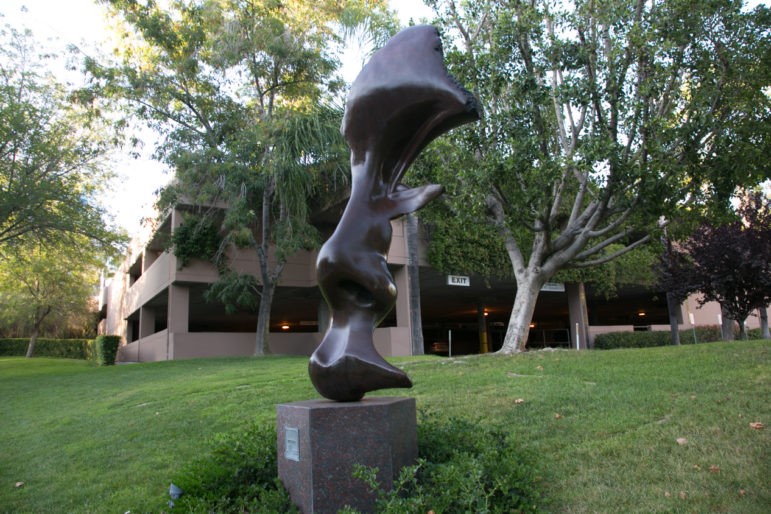
JULIE LEOPO, Voice of OC
“Interface” by Bill Bedford, located in the Olen Pointe business center at Lambert and Pointe, Brea, CA.
Sommer, who has lived in Brea for most of her life, had been thinking about the Art in Public Places program as something she’d like to investigate when she retired.
“I saw ‘Prelude’ every time I drove to work and back and thought, ‘Oh, that is such a wonderful piece. When I retire I want to find every piece that’s part of the APP collection,’ she said. With Sullivan, she found an art partner, as well as a romantic partner.
The Art in Public Places program was spearheaded by Wayne Wedin, who was the City Manager at the time. (He later served on the City Council and as Mayor.) A vacation in Europe impressed upon Wedin how public artwork could distinguish and beautify a city. Orange County’s burgeoning towns were using architectural details, such as red tile roofs or historical street lamps, to differentiate themselves, Wedin said in a phone interview. Brea should become a city of public art, he thought.
“The whole idea is if you look around Brea there’s lots of artwork,” Wedin said. “Many of the projects would have a reception when the artwork was finished. As a city person, I’d go from one group to another, chatting. One group would say, ‘This is the most god-awful thing. My child could do better,’ and another group would say, which I liked better, ‘Well, this is insightful.’ Art is in the eye of the beholder.”
After 44 years, there have been minor tempests over individual pieces. Sommer has heard complaints about nude statues. Carlos Terrés’ “The Wildcat,” in front of Brea-Olinda High School, caused a rumble of discontent back in 1992 because the artist incorporated feathery features into the massive bronze feline. The artist told a reporter for the Los Angeles Times that the feathers were meant to represent an eagle, an Aztec symbol of intelligence. The grumblers complained it didn’t look like a real cat.
The Private-Public Arrangement
It’s possible the program’s public-private arrangement has saved it from having additional and more serious controversies. But it also might contribute to the program’s low-key profile. Artwork is commissioned, owned and is maintained—it’s supposed to be maintained—by the private developer. Pieces sometimes face fast-moving thoroughfares or are hard to see because of shrubbery, so they remain unknown.
Depending on the cost of a development, owners must set aside 1 percent for artwork that is accessible to the public or give that 1 percent as a donation to the city’s artwork fund.
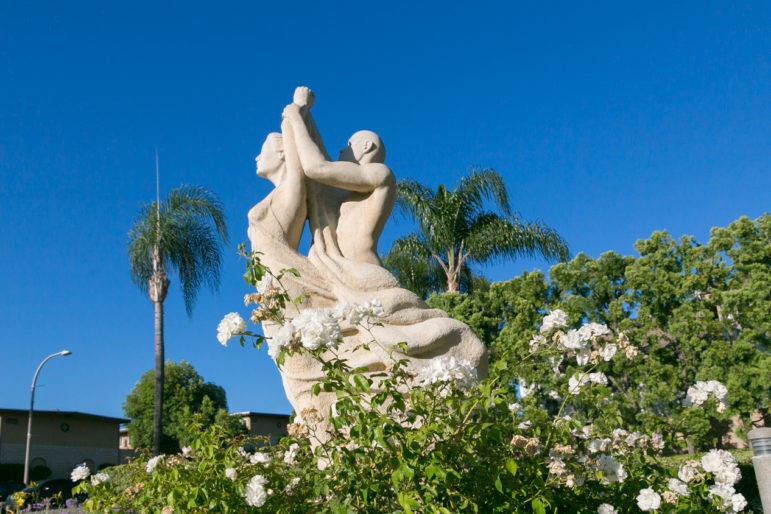
JULIE LEOPO, Voice of OC
“Horizon” by Blake Rankin. The 6-foot by 4-foot limestone sculpture is located on the southeast corner of Birch Street and Poplar Avenue, Brea, CA.
The city has an art commission that reviews the projects to make sure they adhere to city guidelines; for example, pieces need to be lit, said Community Services Management Analyst Jennifer Colacion. The commission does not get involved in the subject matter of the pieces or artist selection. Colacion said the city’s art fund currently has about $80,000. The city council and staff decide how the money is spent. Sullivan and Sommer would love to see some of it go toward sculpture maintenance.
Wedin said he has been talking informally with others about the creation of a sculpture park or outdoor gallery, where artists could sell work and the city could collect tax revenue from the art sales. Both he, Sommer and Sullivan noted that the quality of the pieces has improved over the years. In addition to Saint Phalle and Dill, other prominent artists with works in the collection include Guy Dill (Laddie’s brother), J. Seward Johnson, Jr., and Larry Bell.
Developers have become more invested in the program, Sommer said.
“You can see how there’s been a progression in thinking from the developers,” she said. “The developers at first probably felt encumbered, ‘I have to do this.’ …And now, it’s almost like a competition. ‘We can do something more extravagant or catchy than others have done,’ which is a nice transition. There’s more pride.”
Laura Bleiberg is a contributing writer for Arts & Culture at Voice of OC. She can be reached at laura.bleiberg@gmail.com.
* * * * * * * * * * * * * * * * * *
Daxon: Experts Agree Birch Hills Is A-OK and So Is Brea’s Art in Public Places
Something else good for our city and all of us is Brea’s wonderful Art in Public Places program. Terry Sullivan and Dena Sommer have complied beautiful photos of 177 of the public art pieces into a coffee table book that is available with a Patron of the Arts membership in the Brea Historical Society.
Besides the book, the Patron of the Arts membership has other perks, including special events, Brea Museum and Heritage Center curator Linda Shay said.
The initial membership fee, including the Art in Public Places book, is $100 and renewals are $50 a year. According to Shay, they are working with Sullivan and Sommer on an Art in Public Places exhibit at the museum that will include historical facts about the art pieces and the artists who created them.
Maybe you’ve seen Sullivan’s posts on Nextdoor.com featuring individual art pieces along with information about the artists and most important, where each piece is located in town. Their website, Breasartinpublicplaces.com, shows all of the city’s public art pieces, and an interactive map for visiting them, plus Brea’s bus stop art pieces. They are all amazing.
The Brea Museum and Heritage Center is at City Hall Park. It is open from 2 to 5 p.m. Thursdays and 10 a.m. to 3 p.m. Saturdays; admission is free.
Terri Daxon is a freelance writer and the owner of Daxon Marketing Communications. She gives her perspective on Brea issues twice a month. Contact her at daxoncomm@gmail.com.
* * * * * * * * * * * * * * * * * *
Production of Oil, Marlo Bartels, Northeast Corner of Santa Fe & Tonner Ridge
Program Connects Developers and Community
The small city of Brea covers only 12.43 square miles between La Habra in the west and Chino Hills in the east, and is home to just over 40,000 people.
It’s also home to 178 pieces of public art.
“The size of the collection we have is outstanding compared to the size of our community,” Jenn Colacion, the city’s community services specialist, said. “It’s something that Brea is very proud of.”
Brea’s Art in Public Places (APP) program began in 1975 as one of the first collections of public art in the state, Colacion said. The APP program requires developments valued at $1.5 million or more to install art that is worth at least 1 percent of the project’s total value.
The program was inspired by former City Manager Wayne Wedin’s family trip to Europe in the 1970s. Wedin returned to Brea with a new appreciation for public art, which he hoped to implement in Brea, Colacion said.
The most recent additions to the collection are “Nature’s Retreat I” and “Nature’s Retreat II” by artist Karen Heyl, which were commissioned by the Walden Estates on Lambert Road and Sunflower Street this year. The housing development was required to create new art after its original piece was stolen—something that happens often with bronze pieces in the collection, Colacion said.

“Flora and Fauna” by Marlo Bartels.
TERRY SULLIVAN AND DENA SOMMER
In March of this year, developer Shea Homes introduced nine new APP pieces to the Blackstone community. They were all created by Marlo Bartels, an Orange County-based artist whose mosaics can be found all over Southern California.
He said that he is inspired by things in Brea that “may not be obvious.” When creating two seashell-shaped pieces titled “Paleontological” for the Blackstone community, he was inspired by the fact that this part of the city “used to be under water.” He said that he enjoys finding the connection between the community and the art that he creates.
“One of the main purposes of public art is to create community,” Bartels said. “Some of the best public art does just that. It gives people a sense of pride in their community.”
While developers that meet the $1.5 million value mark must commission art, Colacion believes that the requirement gives developers a “unique opportunity to connect with the community.”
“I think that art gives the opportunity for people to experience things through other’s eyes. Art is in the eye of the beholder,” Colacion said. “We call it our outdoor art gallery. You can drive down the street and see 10 pieces of art on your morning commute. That’s what makes our diverse collection so great.”
Brea residents Terry Sullivan and Dena Sommer made it their goal to photograph each piece of art in the APP program when they became a couple in 2008. They call it their “adventure.”
“This is really our pet project in retirement,” Sommer said. “We grew up in Brea and think so highly of the city and what it gave us, so we’re sort of giving back.”
The couple now runs their own Brea’s Art in Public Places website, where they catalogue the collection with photographs, locations, and the various artists’ names. The city of Brea plans to use the couple’s photographs and website to promote the APP program, Colacion said.
“These type of people create the excitement about the program in the community,” Colacion said. “Having these advocates for the arts in Brea is what makes our community so special.”
The couple enjoys seeking out public art whenever they travel to other Southern California cities or other states. According to Sullivan and Sommer, Laguna Beach is the only Orange County city that compares to Brea in terms of public art. However, the couple said that Laguna Beach differs because it has “more money and less space for big businesses.”
According to the Laguna Beach Visitors website, there are 79 pieces of public art in their collection—nearly 100 fewer pieces than Brea’s collection. The city’s policy also differs from Brea’s in its requirements. Developers with property worth $225,000 or more must create art that is worth at least 1 percent of the total value.
While Colacion said the city’s limited resources prevent the APP Advisory Committee from creating new ways to promote the program, she said residents like Sullivan and Sommer help the APP program to “remain a strong priority of the city.” Sullivan and Sommer plan to continue their “adventure” through the APP program, which Sommer calls “Brea’s pearl necklace.”
“We’re trying to be evangelicals for the program. People in the city of Brea don’t have any idea that this program exists,” Sullivan said. “The art is hiding in plain sight. We’re trying to educate people.”
Emiko Kaneoka is a student journalist at Chapman University participating in the Voice of OC Youth Media program.
* * * * * * * * * * * * * *
Terri Daxon, Orange County Register, February 17, 2017
Daxon: Where’s Brea’s Art? This Brea Couple Knows.
By TERRI DAXON |daxoncomm@earthlink.net | Terri’s Town
I like when people think and do things themselves instead of waiting for the city or someone else to do it.
DIY is often the way to get things done.
That’s what nearly life-long Brea residents Terry Sullivan and Dena Sommer did about Brea’s Art in Public Places.
The couple met in kindergarten at Laurel School and went all through school together, lost touch until their 45th Brea Olinda High School reunion in 2008.
“We’ve been a couple ever since,” said Sullivan.
Their love of Brea’s public art soon followed after that.
It started when Sommer was intrigued by “Prelude,” the art piece with two Native Americans at Central and Berry street she passed daily. Soon she stop by the civic center for an Art in Public Places catalogue, found it incomplete, and was hooked on seeking out the entire collection. After she and Sullivan got together, he also got hooked on it and creating an easy way for people to locate every piece.
“We feel the Art in Public Places program doesn’t get anywhere near its due,” said Sullivan, “When we talk to fellow Breans about it, we are amazed by how small a number of people are even aware of it. We’d like to see that change.”
A little background. The Brea public art program started, I was told, after Wayne and Doreetta Wedin saw public art while on a trip and brought the idea back to Brea in the 1970s. Back then, as now, when a company wants to develop a commercial or residential property they must sponsor a piece of public art, worth at least 1 percent of the project’s assessed value.
In 1975, when the project began, the property had to have a minimum assessed value of $500,000. Today that minimum value is $1.5 million, so we are getting even more valuable art with every new project.
The first art piece, installed in 1975, was “Birds” by King Zimmerman, at Lambert and Associated roads.
At present, said Jenn Colacion, Brea’s community services specialist, there are 169 pieces in the city’s collection. “We expect to have 11 more this coming year,” she said.
Sullivan and Sommer can tell you where every piece of art is located and when it was placed there. They were not contracted by the city, nor have either of them been members of the Cultural Arts Commission or the Art in Public Places Committee. They just took on this project by themselves. Sullivan said they spent many hours communicating with city staff that helped them locate all the art pieces. “Without their help, there’s no way we could have know where all the pieces were,” said Sullivan.
Once they located all the pieces, in 2009 they photographed them and made PowerPoint presentations they showed at a Cultural Arts Commission meeting. Then they created a file that was put on the city’s website, but was taken down when the website was updated some time ago.
No problem, this art-loving couple has continued to catalogue, update photos and map out where every piece of Brea’s public art is located. You can check it all out at breasartinpublicplaces.com. You will be amazed.
Terri Daxon is a freelance writer and the owner of Daxon Marketing Communications. She gives her perspective on Brea issues twice a month. Contact her at daxoncomm@earthlink.net.
